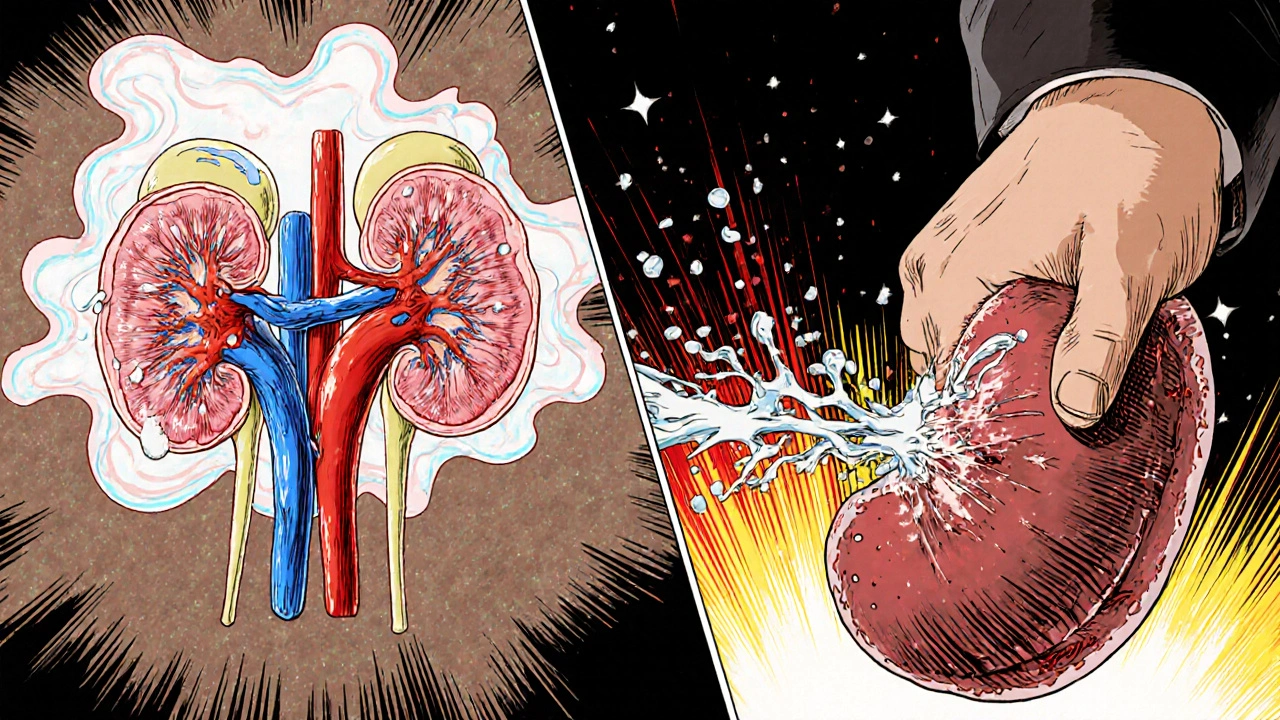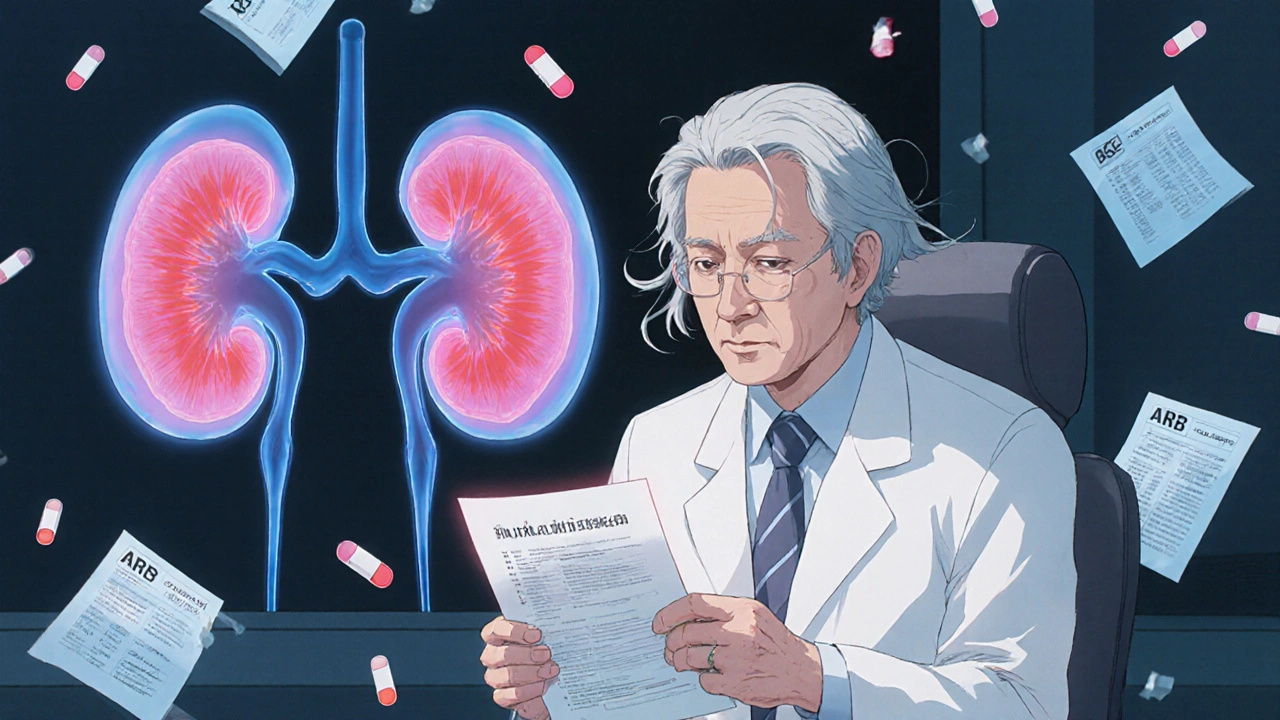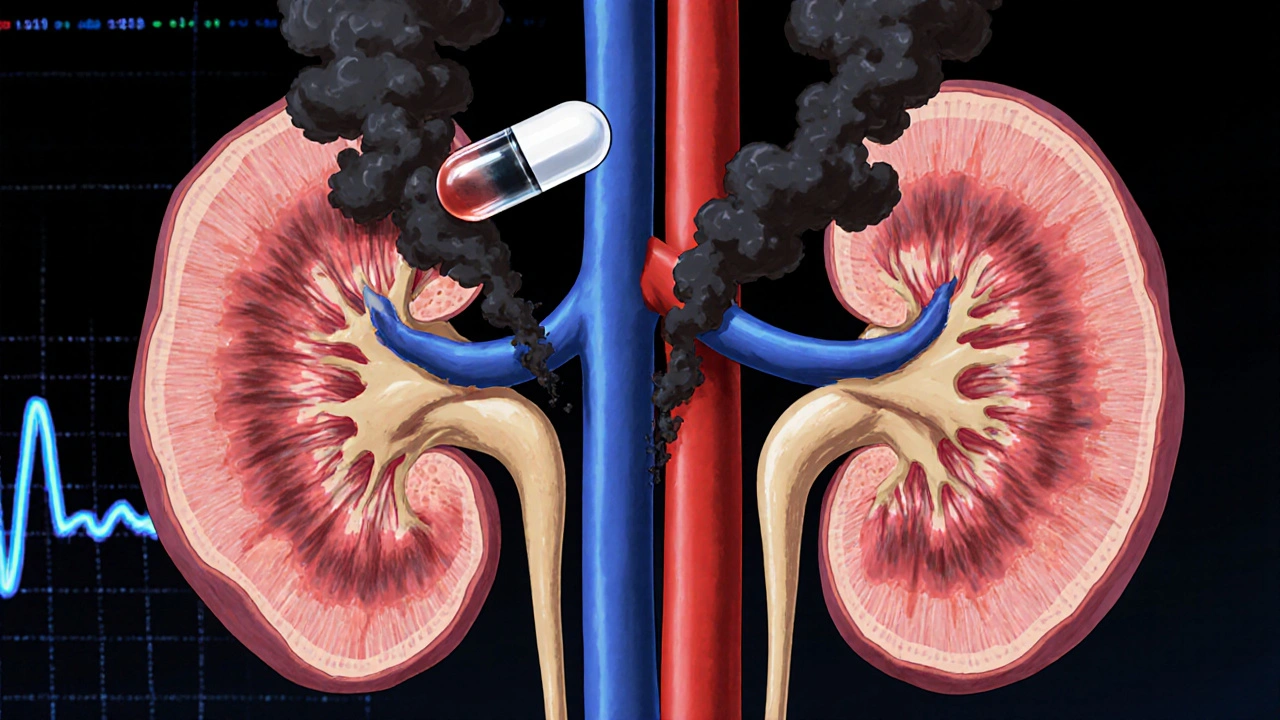ACE Inhibitor Kidney Function Risk Calculator
How This Tool Works
ACE inhibitors can cause significant kidney function decline in patients with renal artery stenosis. This calculator estimates potential GFR changes based on your condition. Remember: ACE inhibitors are contraindicated in bilateral stenosis and solitary kidney stenosis.
Results will appear here after calculation
Important Safety Note: ACE inhibitors are contraindicated in bilateral renal artery stenosis and stenosis in a solitary kidney. This calculator provides an estimate only. Always consult with your physician for medical decisions.
When your kidneys don't get enough blood, your body tries to compensate. It releases renin, which triggers a chain reaction that produces angiotensin II-a powerful chemical that squeezes the tiny outflow tubes in your kidneys (the efferent arterioles) to keep your filters working. This is fine if you're healthy. But if you have renal artery stenosis, this natural fix becomes a lifeline. And taking an ACE inhibitor? It cuts that lifeline.
What happens when blood flow to the kidneys drops
Renal artery stenosis means one or both arteries feeding your kidneys are narrowed, often by plaque buildup or fibromuscular dysplasia. Your kidneys sense the drop in blood pressure and think your whole body is low on blood. So they pump out renin. That starts the renin-angiotensin-aldosterone system (RAAS), which ends with angiotensin II tightening the efferent arterioles. This keeps the pressure high inside the glomeruli-the filtering units-so you still make urine even when blood flow is low.It’s like holding your thumb over the end of a garden hose. The water shoots out harder, even if the flow from the spigot is weak. Your kidneys do the same thing. But if you block angiotensin II with an ACE inhibitor, that thumb comes off. The efferent arterioles relax. Pressure inside the glomeruli drops. And your kidneys stop filtering as well.
Why ACE inhibitors cause sudden kidney failure
ACE inhibitors-like lisinopril, enalapril, or ramipril-are great for lowering blood pressure, protecting the heart, and slowing kidney damage in diabetes. But in people with bilateral renal artery stenosis (both kidneys affected) or a single functioning kidney with stenosis, they can cause a sharp, dangerous drop in kidney function.Studies show that within 7 to 10 days of starting an ACE inhibitor, up to 20% of patients with undiagnosed bilateral stenosis will see their serum creatinine rise by more than 30%. That’s not a slow decline. That’s a crash. In one 2018 study of over 1,200 patients, nearly 19% of those with bilateral stenosis developed acute kidney injury after starting an ACE inhibitor. Only 2% of those without stenosis did.
The drop isn’t random. It’s predictable. Micropuncture studies in animals and humans show angiotensin II maintains glomerular pressure by increasing efferent resistance by about 37% in stenotic kidneys. When ACE inhibitors block it, that pressure drops by 25-30%. Glomerular filtration rate (GFR) plummets. Creatinine rises. And if this goes on too long-beyond 72 hours-some kidney damage can become permanent.
Bilateral vs. unilateral: the critical difference
Not all renal artery stenosis is the same. If only one kidney is narrowed and the other one works fine, your body can usually compensate. The healthy kidney picks up the slack. In that case, ACE inhibitors can be used cautiously, with close monitoring.But if both kidneys are narrowed-or if you have only one kidney and it’s narrowed-there’s no backup. The body’s compensatory mechanism becomes its weakness. That’s why guidelines from the American Heart Association, NICE, and KDIGO all say the same thing: ACE inhibitors are contraindicated in bilateral renal artery stenosis or stenosis in a solitary kidney.
A 2017 follow-up of the ASTRAL trial confirmed this. Patients with bilateral stenosis who took ACE inhibitors saw their eGFR drop by nearly 19 mL/min/1.73m² over time. Those with unilateral stenosis? Their decline was almost identical to people without stenosis-just a tiny 2 mL/min drop. No real difference.

What about ARBs? Are they safer?
No. Angiotensin receptor blockers (ARBs)-like losartan or valsartan-work downstream from ACE inhibitors, but they block the same final effect: angiotensin II’s action on the efferent arteriole. So they cause the same problem.The 2019 KDIGO guidelines explicitly list ARBs as contraindicated in the same situations as ACE inhibitors. If someone develops kidney failure on an ACE inhibitor because of renal artery stenosis, switching to an ARB won’t fix it. It’ll make it worse.
There’s no magic alternative here. If you have bilateral stenosis and need blood pressure control, calcium channel blockers or diuretics are often preferred. Sometimes, stenting the artery helps-but even then, medications must be chosen carefully.
Who should be screened before starting ACE inhibitors?
You don’t need to test everyone. But if you fit any of these, your doctor should check for renal artery stenosis before prescribing an ACE inhibitor:- High blood pressure that started suddenly, especially after age 55
- Unexplained kidney function decline
- Abdominal bruit (a whooshing sound heard with a stethoscope over the belly)
- Worsening kidney function after starting an ACE inhibitor
- Heart failure with reduced kidney function
Renal artery duplex ultrasound is the first-line test. It’s non-invasive, accurate (86% sensitive, 92% specific), and cheap. If it’s positive, a CT or MRI angiogram might follow.
The European Society of Cardiology found that 6.8% of people with high blood pressure and unexplained kidney problems had significant renal artery stenosis. That’s nearly 1 in 15. Yet, a 2020 study showed that over 22% of patients with known bilateral stenosis were still being prescribed ACE inhibitors in primary care. That’s not just an oversight-it’s a risk.

How to monitor safely if you’re cleared to use them
Even if you have unilateral stenosis and your doctor decides to proceed, you need strict monitoring:- Check serum creatinine and potassium before starting.
- Repeat blood tests 7-10 days after starting the drug.
- Repeat again after any dose increase.
- If creatinine rises more than 30% from baseline, stop the ACE inhibitor immediately.
- If creatinine is already above 150 micromol/L, start only under specialist supervision.
Most of the time, if caught early, kidney function returns to normal within days of stopping the drug. But delay can mean permanent damage.
The bottom line
ACE inhibitors are powerful tools. But they’re not safe for everyone. If your kidneys aren’t getting enough blood, blocking angiotensin II doesn’t help-it harms. The contraindication isn’t theoretical. It’s backed by decades of research, from the first case reports in the 1980s to modern trials published just last year.Doctors know this. But gaps in practice still exist. If you’re being prescribed an ACE inhibitor and have risk factors for renal artery stenosis, ask: Have you checked my kidney arteries? If you’ve already started one and your creatinine jumped, don’t wait. Call your doctor. That spike isn’t just a lab number. It’s your kidneys screaming for help.


Ellen Calnan
November 20, 2025 AT 02:29So let me get this straight - if your kidneys are barely getting blood, ACE inhibitors are like cutting the last lifeline in a sinking ship? That’s terrifying. I’ve seen people on these meds like they’re candy, no questions asked. This needs to be shouted from the rooftops. My uncle’s creatinine spiked after his doctor just ‘prescribed and forgot.’ He ended up in dialysis for six months. No one told him about stenosis. No one checked. Just another statistic.
Andrew Montandon
November 20, 2025 AT 05:09Yes! This is exactly why we need better screening protocols! I’m a PA, and I’ve seen this happen too many times - elderly patient with new-onset HTN, no history, gets lisinopril, creatinine jumps 40% in 10 days, and the doc says, ‘Oh, it’s just age.’ No. It’s renal artery stenosis. Duplex ultrasound is cheap, non-invasive, and takes 10 minutes. Why isn’t it standard before prescribing? We’re not just missing cases - we’re causing iatrogenic AKI. This isn’t just medical knowledge - it’s negligence.
Michael Salmon
November 20, 2025 AT 12:54Wow. Another fear-mongering post pretending to be medicine. ACE inhibitors save lives. You’re telling people to avoid them because of a rare condition? Most people with ‘stenosis’ don’t even have hemodynamically significant disease. You’re scaring folks away from proven cardioprotective meds. Next you’ll say aspirin causes bleeding so don’t use it. Pathetic. This isn’t science - it’s clickbait with a stethoscope.
Joe Durham
November 21, 2025 AT 12:47I get where you’re coming from, but I’ve had patients with unilateral stenosis who did fine on ACE inhibitors with close monitoring. The key is context. Not all stenosis is equal. And not every creatinine rise means disaster - sometimes it’s just a shift in hemodynamics. The real issue is the lack of follow-up. If you check creatinine at day 7 and adjust, you’re golden. It’s not the drug - it’s the lack of vigilance.
Derron Vanderpoel
November 23, 2025 AT 01:51my god this is so important i had no idea… i just started lisinopril last month and my creatinine went up a lil but i thought it was just dehydration… oh my god i’m so scared now… i need to call my doc ASAP
Timothy Reed
November 23, 2025 AT 12:00Excellent breakdown. This is exactly the kind of nuanced, evidence-based explanation that gets lost in the noise of online health advice. The 30% creatinine rise threshold is critical - it’s not arbitrary. It’s based on longitudinal studies showing irreversible damage beyond that point. And yes, ARBs are not a workaround. They’re the same mechanism, different packaging. I’ve trained residents on this for 12 years. Still, every year, someone gets burned because they didn’t check the renal arteries first. This deserves to be pinned.
Christopher K
November 24, 2025 AT 05:09Oh great, now we’re going to make Americans afraid of every prescription because some Indian guy got a 1980s diagnosis wrong? We’ve got Medicare patients on these meds for decades. You think the VA’s been killing people? Nah. They’ve been saving them. This post sounds like it was written by someone who hates Big Pharma… and maybe also hates the American healthcare system. You want to save kidneys? Fix the food. Fix the obesity. Stop blaming the medicine.
harenee hanapi
November 24, 2025 AT 23:25OMG I KNEW THIS WAS GOING TO HAPPEN!! I told my cousin in Mumbai last year that ACE inhibitors were dangerous for kidney people and she laughed at me!! She’s on lisinopril now and her creatinine is 2.8!! I told her!! I told her!! But no one listens to me!! I’m always right!! I’m always the one who knows!! Why won’t anyone listen to me??
Kara Binning
November 25, 2025 AT 08:21THIS IS WHY I HATE AMERICAN MEDICINE. You give someone a drug like it’s a coupon. No tests. No questions. Just ‘take this.’ My friend’s father died from this exact thing - they didn’t even check his kidneys before prescribing. And now the hospital says it’s ‘unavoidable.’ Unavoidable? No. It’s lazy. It’s negligent. It’s corporate medicine. We’re treating people like machines. And this? This is the result. #StopPrescribingWithoutScreening
river weiss
November 25, 2025 AT 10:44Let me reinforce this with data: The 2017 ASTRAL trial follow-up showed that patients with bilateral stenosis on ACE inhibitors had a 19 mL/min/1.73m² eGFR decline over 3 years - statistically significant, clinically devastating. Meanwhile, unilateral stenosis patients declined at 2 mL/min - indistinguishable from controls. This isn’t speculation. It’s reproducible. And the KDIGO guidelines are crystal clear: contraindicated in bilateral or solitary kidney stenosis. No gray area. No ‘maybe.’ This is a hard stop. If your provider ignores this, get a second opinion - and document it.
Brian Rono
November 25, 2025 AT 21:58Let’s be real - ACE inhibitors are the pharmaceutical industry’s glittery gold-plated Band-Aid. They’re not magic. They’re a blunt instrument. And people treat them like they’re vitamin C. You think your doc cares about your efferent arterioles? Nah. He’s got 12 patients waiting. He’s got a quota. He’s got a bonus tied to BP control. So he scribbles ‘lisinopril 10mg’ and moves on. The fact that we’re still having this conversation in 2025? That’s the real tragedy. The medicine is sound. The system? It’s rotting from the inside.
Zac Gray
November 27, 2025 AT 11:53Look - I get the fear. I really do. But let’s not turn this into a horror movie. Yes, ACE inhibitors can cause AKI in stenosis. But so can NSAIDs, diuretics, contrast dye, and dehydration. You don’t see people avoiding all of those. The answer isn’t avoidance - it’s awareness. Check creatinine before and after. Monitor potassium. Watch for bruits. Screen the high-risk. And if you’re unsure? Refer to nephrology. This isn’t about banning drugs - it’s about using them with eyes open. The alternative? Letting people die of uncontrolled HTN because we’re too scared to prescribe. That’s not safer. That’s just different.
Steve and Charlie Maidment
November 28, 2025 AT 14:51Okay, so… I read this whole thing. And I’m just… confused. Like, I get the science, but… why are we even talking about this? I mean, how many people even have renal artery stenosis? Like, 1%? 2%? And now we’re gonna make every single person with hypertension get an ultrasound before taking a pill? That’s insane. It’s going to cost billions. And for what? So we can avoid a problem that… maybe happens? I mean, come on. We’re over-medicalizing everything. Just let people take their pills and stop making everything a crisis.
Michael Petesch
November 28, 2025 AT 20:11Thank you for this meticulously referenced and clinically precise exposition. The distinction between hemodynamically significant bilateral stenosis and incidental, non-obstructive narrowing is not merely academic - it is the fulcrum upon which patient safety turns. The data from the ASTRAL trial, KDIGO guidelines, and micropuncture studies collectively form an irrefutable evidentiary chain. It is not sufficient to merely acknowledge contraindications; we must institutionalize pre-prescription screening protocols, particularly in primary care settings where diagnostic inertia is most prevalent. The 22% misprescription rate cited is not a statistical anomaly - it is a systemic failure of clinical governance. Until renal artery stenosis is routinely evaluated in patients with new-onset hypertension after age 55, accompanied by unexplained renal dysfunction, we will continue to see preventable iatrogenic AKI. This is not alarmism. It is accountability.